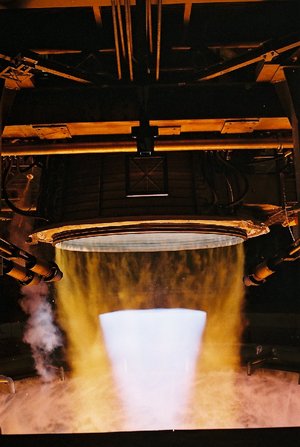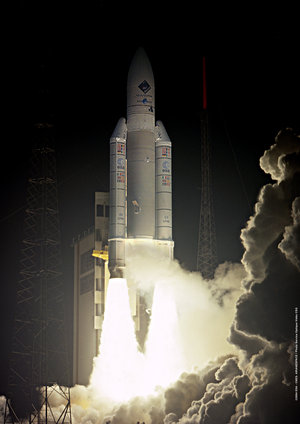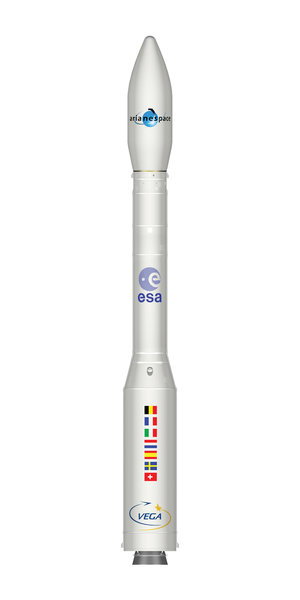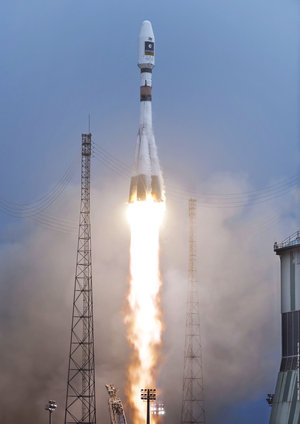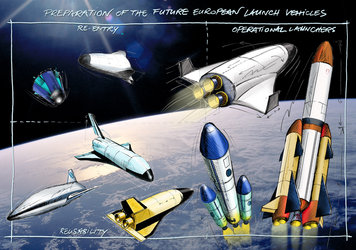Launchers’ Director meets the press
At a press briefing last week in Berlin, the Director of ESA’s Launchers’ Programme, Antonio Fabrizi, gave a brief update on launcher activities. The occasion was the Berlin Air and Space Show, better known as ILA 2004.
Existing programmes
Fabrizi commenced by describing the launch of Rosetta in February this year. An Ariane 5 G+ with delayed ignition of the upper stage engine was used to launch Rosetta on its way to rendezvous with the Comet 67P/Churyumov-Gerasimenko. “Rosetta was put into perfect orbit” he said “and this precision saved fuel that can be used to carry out additional experiments.”
Work is now in progress to bring back to flight the Ariane 5 ECA and the Vulcain 2 engine has been made more robust. Ground tests results are good and a return to flight is planned for late September. “By the end of this month the launcher hardware will be leaving Europe on its way to Europe’s Spaceport in French Guiana,” he said.
Fabrizi next told the press of an extremely important development: an Arianespace and EADS-ST contract for the production of 30 launchers. Signed during ILA 2004, this contract will stabilise the production of Ariane launchers and maintain the necessary level of technical expertise within European industry.
This follows directly on another important contract signed this year between ESA and Arianespace for the EGAS programme (European Guaranteed Access to Space). A programme to ensure that Ariane-5 launchers will be available for future European missions.

Fabrizi reported that work on Vega, Europe’s new small launcher, is proceeding according to plan. “A System Design Review will be concluded on 8 June, initial hardware testing of the Zefiro P80 stage has started and manufacture of the filament wound structure of the upper stage motor has already commenced. As soon as a contractor has been selected work will also commence on the ground segment at the former Ariane-1 launch site.
With regard to the agreement with the Russian Federation to launch Soyuz from Europe’s Spaceport, Fabrizi reported that preparations are ongoing and that a contract for the Soyuz ground segment should be placed before the end of June.
The first phase of the Future Launcher Preparatory Programme (FLPP) is also underway and Fabrizi was pleased to report that contracts will shortly be placed with industry.
Restructuring of the launcher sector

The important restructuring of the launcher sector, started by European Ministers for Space Affairs at the ESA Council meeting in Edinburgh and confirmed at the Council meeting in Paris last year, is proceeding.
Fabrizi described the Ariane programme as “a complex system with many interfaces, involving ESA, CNES, Arianespace and industry, both in Europe and at the spaceport in French Guiana”.
He briefly described the restructuring and said that ESA’s role will be more managerial with direct responsibility for industrial contacts. There will be one prime contractor for Ariane-5 production and development, starting with the PA Ariane-5 production contract, while Arianespace will maintain responsibility for commercialisation and launch operations.
ESA’s approach for restructuring the launchers sector is:
- analysis of processes and definition of perimeters for: preparation, design, development, testing and production
- creation of working groups with all main players
- organisation of seminars with all interfaces to spread the new philosophy
Although the new organisation of ESA’s Launchers’ Programme will not be fully announced until June, Fabrizi was able to report that it will be based on four project teams: Ariane (with assistance from CNES), Vega, Soyuz and Future Programmes.
Industry is also in the middle of restructuring due to the drop in the commercial market for launchers. “It is vital to do this,” Fabrizi emphasised, “while maintaining the know-how in the European launchers’ sector“.
What’s next after Ariane 5 ECA?

Fabrizi emphasised the importance of launcher versatility and reducing costs. “We need,” he said, “a launcher with an upper stage that can carry out multiple ignitions and Ariane 5 ECA cannot do this."
Future launchers’ developments will include studying the different trade-offs between different vehicle concepts. Is it more economical and practical to have reusable launchers or low-cost expendable launchers? This is one of the most important questions that ESA’s Launchers’ Programme has to answer and studies are starting now into all aspects of a next generation launcher to ensure that Europe makes the right decision.
“In depth reports by ESA within the FLPP, and by the space agencies of ESA Members States, will come together to ensure that Europe will have a next generation launcher available in 2015-2020, based on new technologies.“



